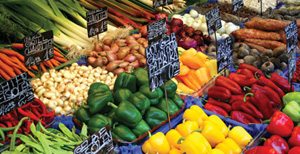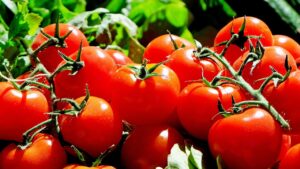Concerns over the malnutrition of one billion people globally is putting this health issue front and center on the world stage, but the nutrition challenge cannot be solved solely by the health sector—farmers are the first nutrient providers.
Often called the hidden hunger, malnutrition is rising on the global radar screen. Since the spike in food prices in 2007-08, there has been renewed discussion of hunger, but the issue is bigger than that. Food security is not only about the quantity of food we consume; it is also about the quality and diversity of that food as well. Nutrition insecurity contributes to the deaths of almost 10 million people each year and affects the health of one billion. Life-threatening illnesses can be caused by a lack of protein or micronutrients such as iodine, vitamin A and iron. Malnutrition weakens our immune systems, exacerbates the effect of diseases such as measles, malaria, pneumonia and diarrhoea, and can permanently impair long-term physical and cognitive development.
At the same time, there are also concerns about over-nutrition. Leaders in the health sector are working to make obesity a major social issue, not just a medical one. Recently, associations for cancer, heart and diabetes have banded together to focus on chronic, non-communicable diseases. Discussions about diet and nutrition will be growing even louder in the months ahead, as there is a concerted effort to elevate the importance of lifestyle choices, including increased fruit and vegetable consumption. Scrutiny is intense on the fat and salt content in foods, as well as how food is processed.
Already there have been significant bans on trans-fat in food, increased labelling requirements and much consumer education. Currently the United States is considering changing the ways in which highly processed foods are marketed to children. There are also advocates for labelling dairy and meat as high-risk foods due to saturated fat content. Another idea recommends imposing “fat taxes” and “thin subsidies”—essentially taxing food that could be fattening and subsidizing fruits and vegetables. Interestingly, one scenario run on such a tax/subsidy program suggests it would save a substantial number of lives among people who already consume close to the recommended levels of fat, fruits and vegetables, but would likely have little effect on the diets of people who are far from the recommended levels. Thinking about the right way to address nutrition is increasingly the focus of global policy-making.
Agriculture’s Role
Traditionally, nutrition security has been viewed as the realm of health professionals. Yet the global nutrition challenge cannot be solved solely by the health sector—farmers are the first nutrient providers. Continued focus on increasing agricultural productivity is arguably the first step to improving food and nutrition security.
At a policy level, discussion of what agriculture can do is complex. Two competing visions state that either:
1) Agriculture is producing enough, but too much of the harvest is going to other uses such as biofuel; or
2) Increased population and development around the world is resulting in higher caloric demand, so agriculture must produce more.
One perspective on which everyone seems to agree is that agriculture must do better to help address nutrition issues. From crop rotations to growing healthier crops, the world’s farmers will be getting stronger signals encouraging them to produce food with the highest possible nutritional value. Increasingly, governments are looking at using purchasing power and subsidies to support desired nutritional outcomes (for example, buying organic produce for school feeding programs).
Plant Breeding
There has been criticism of production shifts which have focused primarily on a few key crops. For example, increased consumption of cereals, at the expense of some traditional crops, particularly pulses, is perceived as a shortcoming that has exacerbated malnutrition challenges in some countries. Variety is key. Plant breeding, in all its forms, has a role to play in the availability of food. Remarkably few of the policy discussions on plant breeding have focused on developing low linoleic oilseeds or on other improvements to food crops. Instead, there is a concern that plant breeding is only focused on yield, and is too concentrated on a limited number of crops.
Particularly, there is interest around the world in breeding more healthy fruits and vegetables. Selecting a diverse range of vegetables that are more nutrient-dense has recently been encouraged. Helen Keller International has created a garden program in Asia that can feed families of four to five, providing a good range of nutrients for a year from just six-by-six meter plots.
Biofortification
Plant breeding is also a way to achieve biofortification. One of the most cost-effective ways to tackle malnutrition is through breeding crops with higher nutrient content, particularly of micronutrients such as iron, zinc, and vitamin A. This has advantages over supplements (such as vitamins) as it allows farmers to produce a valuable product, targets solutions more directly and reduces distribution problems.
Perhaps the best example of the success of biofortification is a project involving the orange-fleshed sweet potato led by HarvestPlus. From 2007 to 2009, HarvestPlus distributed the potato, richer in vitamin A than other potatoes, to more than 24,000 households. In Mozambique, 75 percent of project households adopted the variety, as did 65 percent in Uganda. For the most part, the project did not increase total potato acreage, but shifted production from white-fleshed to healthier orange-fleshed varieties.
The great news is that four years from the launch of the project, 61 percent of the farmers involved in Uganda and 68 percent of those in Mozambique who were given the orange sweet potato are still growing it.
As a result, total vitamin A intake has increased, especially among children and women. Notably, for children aged 6-35 months, the orange-fleshed sweet potato contributed 78 percent of their total vitamin A intake in Mozambique and 53 percent in Uganda. In the long run, the improved exposure to vitamin A could help save their eyesight.
Among the lessons learned from this early success story in biofortification is the need to take the total life cycle of a new crop into account. That includes giving farmers agronomic information on crop production, supply chain interventions, particularly in local markets, demand creation through education, and behaviour change among consumers.
Food Policy
Individual programs like that of HarvestPlus give hope for achieving real outcomes in using biofortification to fight malnutrition and achieve food security. However, the debate over food policy moves far beyond just one program. It touches on markets for agricultural commodities, stockpiles, labelling and consumer choice. Many experts are engaged in this debate, including doctors, nutritionists and government policy makers. Shockingly, among the least consulted groups is the one most likely to be able to affect change—farmers.
The opinions of the very people engaged in food production are too often seen as irrelevant when the larger food questions are addressed. Ironically, even though they grow food, smallholder farmers represent one half of the global poor and a large portion of the malnourished. They, and farmers in all parts of the world, must be part of the solution. Joachim von Braun of the Center for Development Research says: “Sectors don’t matter, projects don’t matter. Results matter.” He is absolutely right, but without the engagement of agriculture, most of these results won’t be achievable. Robynne M. Anderson












